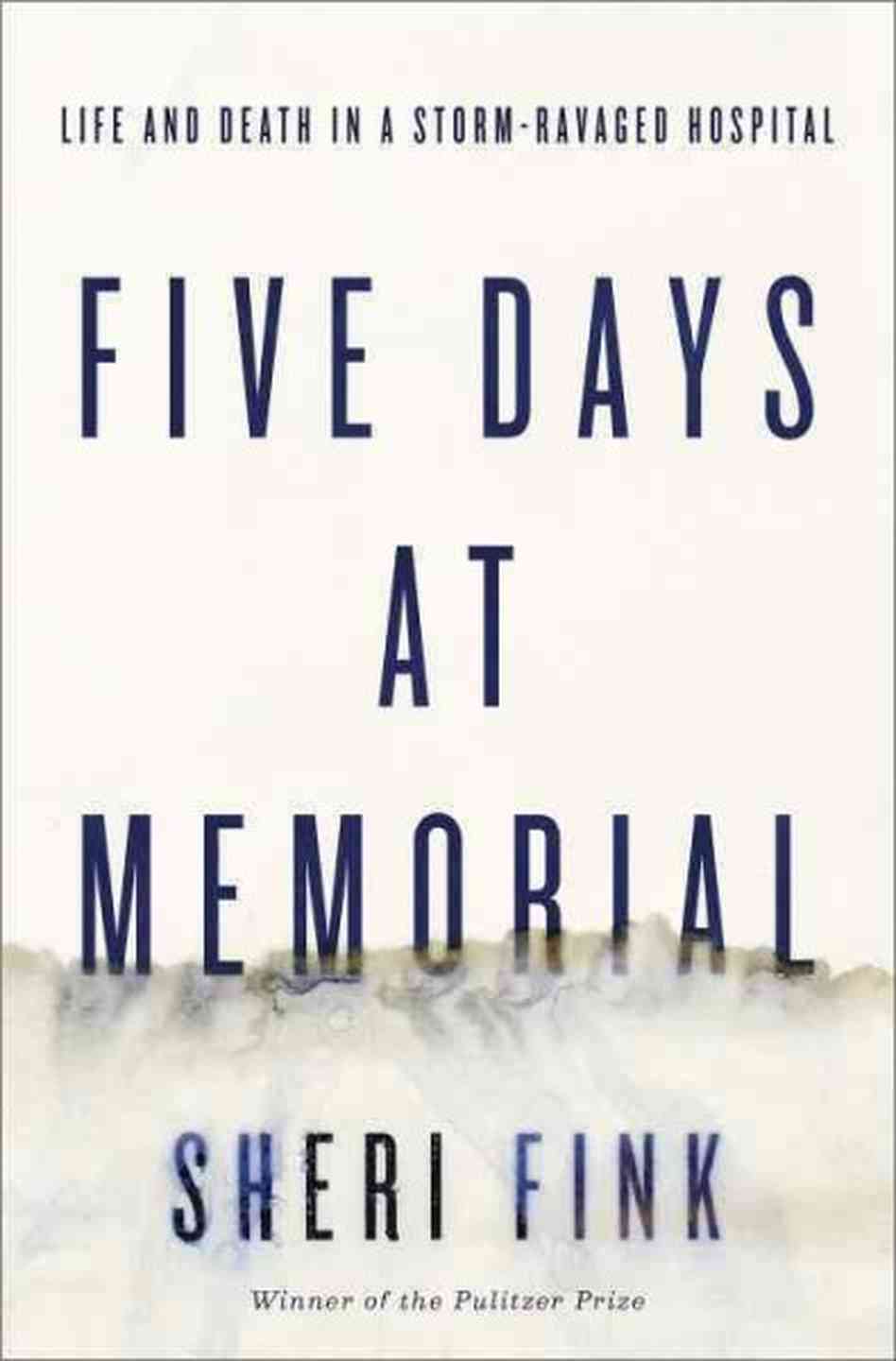5 Days at Memorial: Life and Death in a Storm Ravaged Hospital by Sheri Fink
 5 Days at Memorial: Life and Death in a Storm Ravaged Hospital by Sheri Fink – This is a great book for anyone who works in a hospital especially doctors and nurses who realize they could be on call when a disaster might strike. Also include yourself in this group if you are a hospital administrator or someone who likes to wrestle with ethical dilemmas. Be prepared for a lot of repetition, medical details that may all seem to be almost the same to most people as well as for some dips into the history of this hospital, other disasters and a course in ethics over the years even dating back to ancient times. If you can handle all of this, you really have an exciting, intellectually stimulating book with a look at disaster medicine, making medical and ethical decisions under difficult circumstances and some good legal battles. The main event was the 2005 Hurricane Katrina, which was the costliest natural disaster, as well as one of the five deadliest hurricanes in the history of the United States. At least 1,833 people died in the hurricane and subsequent floods. This book deals with the impact of the storm on Memorial Hospital in New Orleans, which was a 312-bed hospital, which included patients receiving intensive care and a larger section of the hospital where critically ill patients were treated. As the floodwater rose, most of the power in the hospital was irretrievably lost. There was no sanitation, and they were running out of food. Indoor temperatures were as high as 110 F degrees. At one point there were over 2000 people in the hospital as the numbers swelled with families of patients and staff as well as refugees from the surrounding city. The hospital became surrounded by water and there was no way to leave by car. A makeshift helipad was established on the roof but to get there patients, had to be carried up several flights of stairs usually in the dark and passed through a hole in the wall to get to another part of the hospital complex and up additional stairs. There was limited oxygen for these patients and for some the nurses had to squeeze a balloon like device to get the air into their lungs and drip an IV into their veins while going up the stairs. It was difficult getting enough helicopters to remove all the people from the hospital. Decisions had to be made which patients to evacuate first. Should it be the ones that were barely alive and wouldn’t be expected to even survive the trip to another location or perhaps already had a fatal illness where their demise was expected in a few days or should the patients go first who had a better long term outlook but still required hospital care?? Should the preference or order of care be influenced if the patient had a DNR order, meaning do not resuscitate the patient if their heart stops or if they stop breathing. As the first three or four days passed most of the people were evacuated (where they were evacuated to was another problem). There was confusion and questions about the actions by the corporation that owned the hospital and what arrangements they were making to help the stranded hospital’s need for evacuation. Outside the hospital gunshots were heard and there were concerns that looters might enter the hospital by boat. There was a concern about the physical integrity of the old hospital walls. You would think that the National Guard and the US Government should have done a heroic operation to save everyone from the beginning. They apparently were saving people from rooftops of their homes, helping out in the Superdome, which was the place of last resort for the people of New Orleans who weren’t able to escape before the flood, as well as sporadically appearing on the helicopter pad. In the end there were a small number of doctors and nurses trying to care for the remaining and sickest patients. There was concern that even moving some of them would be fatal. One man was so obese that they couldn’t figure out how to move him. Some patients were clearly in the last hours hours of their lives. Others would soon be that way if they didn’t get more intensive care. One of the remaining doctors along with two nurses was Dr. Anna Pous, a very compassionate and brilliant ENT surgeon who had a history of reconstructing patients with advanced cancer. She found herself faced with the task of trying to relieve the suffering of several remaining patients. It is well known to physicians and nurses who treat dying patients, that morphine often in combination with a rapid acting tranquillizer such as Versed, given intravenous will relieve the pain and agonizing difficulty breathing in the final stages of life. It is also known that this treatment could hasten their demise. Dr. Pous appeared to have made the decision to have several patients receive large doses of morphine and Versed, which would painlessly end their lives. At a later point in time , this action was felt by some people to be murder. In fact, Dr. Pous was actually arrested, handcuffed and was with two nurses charged with second-degree murder. The response of the medical community from this hospital and from across the country, the legal and emotional reactions of some of the patient’s families, the media hype and the ethical questions which were being asked, were an important part of this book. The book provides few answers and lots of stimulating questions. The author won a Pulitzer Prize for her reporting on this subject in the New York Times Magazine. If you are drawn to this subject you will not be disappointed.
5 Days at Memorial: Life and Death in a Storm Ravaged Hospital by Sheri Fink – This is a great book for anyone who works in a hospital especially doctors and nurses who realize they could be on call when a disaster might strike. Also include yourself in this group if you are a hospital administrator or someone who likes to wrestle with ethical dilemmas. Be prepared for a lot of repetition, medical details that may all seem to be almost the same to most people as well as for some dips into the history of this hospital, other disasters and a course in ethics over the years even dating back to ancient times. If you can handle all of this, you really have an exciting, intellectually stimulating book with a look at disaster medicine, making medical and ethical decisions under difficult circumstances and some good legal battles. The main event was the 2005 Hurricane Katrina, which was the costliest natural disaster, as well as one of the five deadliest hurricanes in the history of the United States. At least 1,833 people died in the hurricane and subsequent floods. This book deals with the impact of the storm on Memorial Hospital in New Orleans, which was a 312-bed hospital, which included patients receiving intensive care and a larger section of the hospital where critically ill patients were treated. As the floodwater rose, most of the power in the hospital was irretrievably lost. There was no sanitation, and they were running out of food. Indoor temperatures were as high as 110 F degrees. At one point there were over 2000 people in the hospital as the numbers swelled with families of patients and staff as well as refugees from the surrounding city. The hospital became surrounded by water and there was no way to leave by car. A makeshift helipad was established on the roof but to get there patients, had to be carried up several flights of stairs usually in the dark and passed through a hole in the wall to get to another part of the hospital complex and up additional stairs. There was limited oxygen for these patients and for some the nurses had to squeeze a balloon like device to get the air into their lungs and drip an IV into their veins while going up the stairs. It was difficult getting enough helicopters to remove all the people from the hospital. Decisions had to be made which patients to evacuate first. Should it be the ones that were barely alive and wouldn’t be expected to even survive the trip to another location or perhaps already had a fatal illness where their demise was expected in a few days or should the patients go first who had a better long term outlook but still required hospital care?? Should the preference or order of care be influenced if the patient had a DNR order, meaning do not resuscitate the patient if their heart stops or if they stop breathing. As the first three or four days passed most of the people were evacuated (where they were evacuated to was another problem). There was confusion and questions about the actions by the corporation that owned the hospital and what arrangements they were making to help the stranded hospital’s need for evacuation. Outside the hospital gunshots were heard and there were concerns that looters might enter the hospital by boat. There was a concern about the physical integrity of the old hospital walls. You would think that the National Guard and the US Government should have done a heroic operation to save everyone from the beginning. They apparently were saving people from rooftops of their homes, helping out in the Superdome, which was the place of last resort for the people of New Orleans who weren’t able to escape before the flood, as well as sporadically appearing on the helicopter pad. In the end there were a small number of doctors and nurses trying to care for the remaining and sickest patients. There was concern that even moving some of them would be fatal. One man was so obese that they couldn’t figure out how to move him. Some patients were clearly in the last hours hours of their lives. Others would soon be that way if they didn’t get more intensive care. One of the remaining doctors along with two nurses was Dr. Anna Pous, a very compassionate and brilliant ENT surgeon who had a history of reconstructing patients with advanced cancer. She found herself faced with the task of trying to relieve the suffering of several remaining patients. It is well known to physicians and nurses who treat dying patients, that morphine often in combination with a rapid acting tranquillizer such as Versed, given intravenous will relieve the pain and agonizing difficulty breathing in the final stages of life. It is also known that this treatment could hasten their demise. Dr. Pous appeared to have made the decision to have several patients receive large doses of morphine and Versed, which would painlessly end their lives. At a later point in time , this action was felt by some people to be murder. In fact, Dr. Pous was actually arrested, handcuffed and was with two nurses charged with second-degree murder. The response of the medical community from this hospital and from across the country, the legal and emotional reactions of some of the patient’s families, the media hype and the ethical questions which were being asked, were an important part of this book. The book provides few answers and lots of stimulating questions. The author won a Pulitzer Prize for her reporting on this subject in the New York Times Magazine. If you are drawn to this subject you will not be disappointed.













